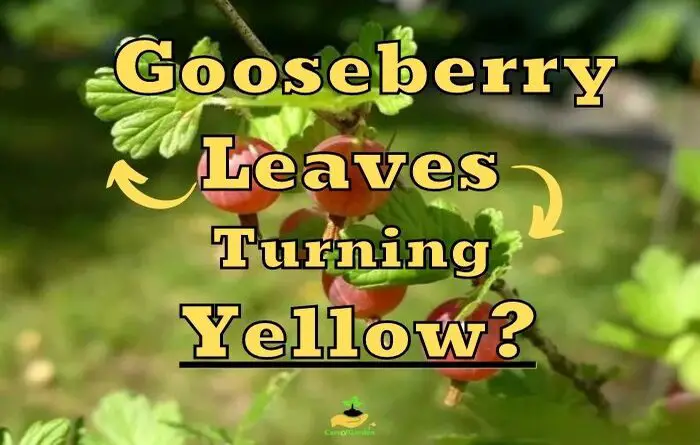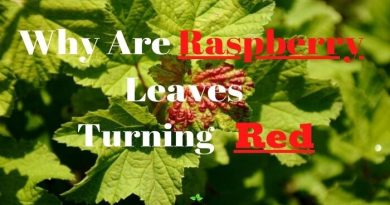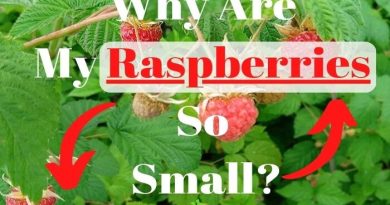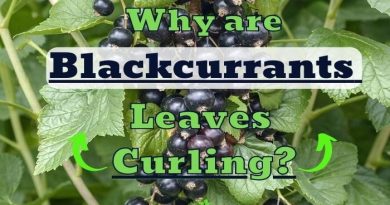Gooseberry Leaves Turning Yellow: 4 Reasons And Solutions
If you suddenly notice that your gooseberry leaves are turning yellow, it is very important to recognize the reasons at the very beginning and eliminate them as quickly as possible.
| Reasons Gooseberry Leaves are Turning Yellow: |
|---|
| 1. Incorrect watering |
| 2. Nutrient deficiency |
| 3. Diseases |
| 4.Pests |
1. Incorrect watering
When it comes to gooseberries, the lack of water is the main reason why leaves are turning yellow. This issue happens during the months of May and June when the gooseberry seedlings are young and high temperatures combined with lack of rain is caused by the start of summer season.
The first symptoms for lack of water on gooseberries are: small upper leaves, lower leaves that turn yellow and curl, and a poor yield.
It is known that gooseberries require regular watering in the first 3 months after planting, especially if the weather is hot.
Moderate temperatures allow you to water gooseberries 3 times per season:
- The end of May – the beginning of June, when leaves are actively formed.
- In June, while the berries ripen. It is important here not to interrupt watering, so that the berries grow large and the harvest is plentiful.
- After picking fruit. The lack of moisture can adversely affect the laying of flower buds, and this will reduce next year’s harvest.
Compared to currants, gooseberries are more drought resistant. The gooseberry thrives in cool but never soggy soil.
Treatment
For watering, use only warm water. Each gooseberry bush requires approximately up to 20 liters or 5 gallons of water(2 buckets of water) depending on the type of soil, which is poured under the gooseberry roots so that the soil is moistened to a depth of 30-40 cm.
In order to prevent the roots from drying out, you can dig a shallow groove to ensure the moisture stays at the root.
Water once or twice a week, preferably in the evening. Increase frequency in hot, dry weather and during flowering. At temperatures above 77°F (25°C), you need to water the gooseberry bushes every 7 days if it hasn’t rain.
2. Nutrient deficiency
Yellow leaves are a sign that gooseberries lack nutrients, especially at the start of the season. In this case, we are talking about nitrogen, which stimulates the growth of the vegetative mass and is also a component of chlorophyll, without which such an important process as photosynthesis is impossible.
With a lack of this macronutrient, the gooseberries experience a lack of oxygen, which leads to a slowdown in plant growth, the leaves begin to turn yellow, the lower leaves curl and fall off.
Nitrogen deficiency often occurs in soils with high acidity and an abundance of weeds.
Treatment
To quickly treat lack of nitrogen in gooseberries, you can use potassium nitrate, also called saltpeter which will be absorbed faster.
Saltpeter is recommended to be used on hot days (in the summer) because this allows them to be absurd more easily. Use approximately 20 grams of potassium nitrate per 1 square meter of soil.
Alternatively you can use:
- Ammonium nitrate, where 35% of nitrogen is contained in the ammonium and nitrate form.
- Urea and urea are amide fertilizers containing 46% nitrogen.
- Ammonium sulfate, or ammonium sulfate, where at least 20% nitrogen.
3. Diseases
Unfortunately, if the above causes of yellowing of the leaves of gooseberry bushes are easily eliminated, then it will take much longer and more thoroughly to deal with possible diseases that lead to drying, twisting and yellowing of the shoots and leaves of currants and gooseberries.
So, what diseases can cause the leaves to turn yellow and fall off?
Verticillium wilt of gooseberries
Verticillium wilt is the most common disease that causes yellowing of the gooseberry leaves.
It infects the young gooseberry plant and after a few months brings it to a complete decline. In addition to yellow leaves, during the parasitism of verticillium, you can see that the vessels, veins of the plant have acquired a brown tint.
Verticillium fungus parasitizes inside the vessels of the roots, as a result of which they receive less nutrients, begin to grow poorly, and the leaves turn yellow, dry and fall off, starting from the lower ones.
It will get on the gooseberry roots from contaminated soil or fertilizers. The fungus develops quite quickly, soon creating extensive gums, that is, colonies of the fungus.
In addition to the parasitism itself, which the fungus conducts, feeding on gooseberry juices (useful substances), it also leaves its metabolic products (toxins) , which further worsen the condition of the gooseberry plant, killing leaves and shoots.
If left untreated, verticillium will completely destroy gooseberries.
Treatment
Due to the fact that the fungus develops and spreads rapidly, it can cover not only one gooseberry bush. But also affect all gooseberry bushes on the site, passing to other types of plants, so it would be advisable to immediately fight it.
Fertilizers with potassium significantly reduce the number of fungi in the soil and help gooseberries recover. They need to be added to the aisles of gooseberries.
It is also recommended to disinfect the bushes with a 1% solution based on Bordeaux mixture during leafing, regardless of whether gooseberries were sick before.
As a preventive measure, planting gooseberries in clean areas is used. The same top dressing with potash fertilizers throughout the gooseberry life cycle will help reduce the risk of a fungal infection.
Gooseberry mosaic virus
This disease is caused by a virus and appears on the leaves as round, blurry pale yellow spots with a light green center located along the veins. Over time, the spots merge, the leaf turns completely yellow, the affected tissue between the veins turns white and dries.
Treatment
Most importantly, this disease cannot be treated, so the only way out is to remove and further burn the affected bushes.
But the easiest way is to prevent the appearance of fungus on the site. To do this, you need to purchase only healthy and proven seedlings of such varieties that are able to resist diseases.
4. Pests
Spider mites
Among the pests, the biggest “lover” of gooseberries is the spider mite.
Spider mites can suck out nutrients from the leaves, as a result of which they will turn yellow and dry out. The bright orange females that emerge from the wintering grounds are clearly visible on the underside of young leaves.
Later, you can easily recognize a damaged plant by spider web nests that braid the tops of young shoots – during the summer, the pest gives several generations.
Plants suffer more from the pest in dry weather. As a result, not only are the leaves damaged, but the yield is also noticeably reduced when the unripe berries fall off.
Remove them with a cotton swab soaked in rubbing alcohol or introduce the Australian ladybug ( Cryptolaemus) who will be happy to devour them.
Aphids
Aphids can cause a lot of trouble for gooseberries . Both adult insects and their larvae actively suck out literally all the juices from plants, and during the season the aphid gives several generations of offspring.
The appearance of aphids is accompanied by swelling on the upper side of the leaves, yellowing, twisting and further falling off.
To remove aphids you need to introduce lacewings or ladybugs, which are insect predators of aphids . You can also choose to spray black soap on the gooseberry leaves to get rid of aphids.
Currant borer( Synanthedon tipuliformis)
The insect is dangerous at the stage of caterpillars, which literally bite into the stems, contributing to the disruption of photosynthesis, thus the nutrition of the leaves. As a result, damaged shoots and leaves wither, turn yellow and die.
Pests can be controlled using the following steps:
- Mandatory collection and destruction of gooseberry fallen leaves;
- Loosening the soil under the gooseberry, covering it with a thick layer of mulch;
- Cut and burn of all insect-infested and weakened shoots and leaves;
- Spray gooseberries with infusion of onions, garlic, mustard and tobacco;
- Timely spraying of currants and gooseberries with insecticides;
- Regular disinfection of seedlings and cuttings.
How to Prevent Gooseberry Leaves from Turning Yellow
The following steps should be taken to prevent gooseberry leaves from turning yellow:
- Clean the soil from fallen leaves in the autumn.
- Loosen and mulch the soil under gooseberries.
- Regularly inspect gooseberries for pests or diseases.
- Affected gooseberry leaves with signs of insect activity, are cut out and burned.
- Choose gooseberries that are resistant to diseases.
- Apply preventive treatments with a 1% solution of Bordeaux mixture (or other copper-containing solutions) at the stages of leaf blooming, bud formation and after flowering.
Conclusion
As you have seen in this article, for the gooseberry leaves not to turn yellow, regular watering, fertilizing, disease and pest prevention will protect and keep gooseberry healthy.
Of course they can. Moreover, it is worth noting that aphids are one of the most common root causes of yellowed gooseberry leaves.
Therefore, having found such a pest on a given fruit plant, it is necessary first of all to get rid of the pest itself.
Yes they can. First of all, this plant requires careful watering. Lack of watering can achieve the same result, yellowing of the leaves.
In this regard, it is recommended to increase watering, spray from pests and observe the plant in order to prevent other issues.




